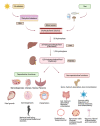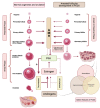A Narrative Review of Current Understanding of the Pathophysiology of Polycystic Ovary Syndrome: Focus on Plausible Relevance of Vitamin D
- PMID: 34063169
- PMCID: PMC8124569
- DOI: 10.3390/ijms22094905
A Narrative Review of Current Understanding of the Pathophysiology of Polycystic Ovary Syndrome: Focus on Plausible Relevance of Vitamin D
Abstract
Polycystic ovarian syndrome (PCOS) is the most prevalent endocrinopathy of reproductive years. Salient features in presentation of patients PCOS include menstrual dysfunction, hyperandrogenism and/or polycystic appearance of ovaries on ultrasound. While the diagnosis of PCOS depends on presence of specified criteria, misdiagnoses are common. Despite years of extensive research, the exact aetiology of PCOS remains largely unknown. In the past decade, apart from insulin resistance and hyperandrogenemia, anti-mullerian hormone (AMH), an important marker of ovarian reserve, and vascular endothelial growth factor (VEGF), a crucial factor in angiogenesis, have been examined as plausible players of causative relevance for PCOS. Vitamin D, a sex-steroid hormone that is universally known for its relevance for skeletal health, has received increasing attention due to growing evidence supporting its pivotal in reproductive physiology and in PCOS. In this review we summarize our current understanding of the mechanisms relevant to the pathophysiology of PCOS and examine the role of vitamin D signalling in this context.
Keywords: anti-mullerian hormone; polycystic ovarian syndrome; vascular endothelial growth factor; vitamin D.
Conflict of interest statement
The authors report no conflict of interest.
Figures






Similar articles
-
Polycystic ovarian morphology and the diagnosis of polycystic ovary syndrome: redefining threshold levels for follicle count and serum anti-Müllerian hormone using cluster analysis.Hum Reprod. 2017 Aug 1;32(8):1723-1731. doi: 10.1093/humrep/dex226. Hum Reprod. 2017. PMID: 28854584
-
The prevalence of polycystic ovary syndrome in a normal population according to the Rotterdam criteria versus revised criteria including anti-Mullerian hormone.Hum Reprod. 2014 Apr;29(4):791-801. doi: 10.1093/humrep/det469. Epub 2014 Jan 16. Hum Reprod. 2014. PMID: 24435776
-
Interactions between androgens, FSH, anti-Müllerian hormone and estradiol during folliculogenesis in the human normal and polycystic ovary.Hum Reprod Update. 2016 Nov;22(6):709-724. doi: 10.1093/humupd/dmw027. Epub 2016 Aug 27. Hum Reprod Update. 2016. PMID: 27566840 Review.
-
AMERICAN ASSOCIATION OF CLINICAL ENDOCRINOLOGISTS, AMERICAN COLLEGE OF ENDOCRINOLOGY, AND ANDROGEN EXCESS AND PCOS SOCIETY DISEASE STATE CLINICAL REVIEW: GUIDE TO THE BEST PRACTICES IN THE EVALUATION AND TREATMENT OF POLYCYSTIC OVARY SYNDROME--PART 1.Endocr Pract. 2015 Nov;21(11):1291-300. doi: 10.4158/EP15748.DSC. Endocr Pract. 2015. PMID: 26509855
-
Anti-Müllerian hormone and polycystic ovary syndrome.Endokrynol Pol. 2017;68(1):74-78. doi: 10.5603/EP.a2016.0065. Epub 2016 Dec 5. Endokrynol Pol. 2017. PMID: 27918066 Review.
Cited by
-
Mechanisms Involved in the Relationship between Vitamin D and Insulin Resistance: Impact on Clinical Practice.Nutrients. 2021 Oct 1;13(10):3491. doi: 10.3390/nu13103491. Nutrients. 2021. PMID: 34684492 Free PMC article. Review.
-
A Comparative Study of Food Intake and Adipose Tissue Distribution in Saudi Women with Polycystic Ovarian Syndrome.Healthcare (Basel). 2024 Feb 1;12(3):369. doi: 10.3390/healthcare12030369. Healthcare (Basel). 2024. PMID: 38338254 Free PMC article.
References
-
- Goodman N.F., Cobin R.H., Futterweit W., Glueck J.S., Legro R.S., Carmina E., American Association of Clinical Endocrinologists (AACE) American College of Endocrinology (ACE) Androgen Excess and PCOS Society (AES) American association of clinical endocrinologists, american college of endocrinology, and androgen excess and pcos society disease state clinical review: Guide to the best practices in the evaluation and treatment of polycystic ovary syndrome—Part 1. Endocr. Pract. 2015;21:1291–1300. doi: 10.4158/EP15748.DSC. - DOI - PubMed
Publication types
MeSH terms
Substances
Grants and funding
LinkOut - more resources
Full Text Sources
Medical
Miscellaneous

